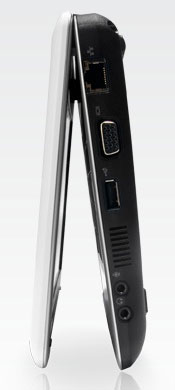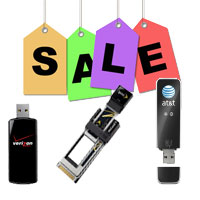Which Should You Choose?
It depends on what you’re using it for. There are upsides and downsides to a 3G netbook and a broadband card.
The Ideal Netbook (A Quick Recap)
The mobile broadband netbook will support practically any carrier worldwide. To do that, the 3G netbook radio must support GSM as well as CDMA technology. For the United States, that means Sprint and Verizon’s EVDO networks as well as AT&T’s HSPA network.
One such radio is Gobi, made by Qualcomm. Currently they’re being put into HP laptops and give some very flexible advantages. However, most carriers want you to lock into only their service before even buying the laptop.
Advantages of a 3G Netbook
Besides reducing power consumption (less than some broadband cards) and better reception in some cases, there’s no broadband card to break.
Another practical advantage is for international travelers. While being on a contract in the US with Verizon, one could travel to Europe and subscribe to a ‘pay as you go’ plan or prepaid plan.
Disadvantages of a 3G Netbook
Most people have laptops for more than 2 years. With built-in mobile broadband tied to one carrier, you’d most likely be locked into a 2 year contract.
After that period is up, you wouldn’t have the option to switch to a network that’s improved and can better serve your needs.
While your original provider may enjoy you being stuck with them for so long as you have your laptop, you probably won’t.
Advantages of a Broadband Card
Price.
 Mobile broadband cards can usually be had for free with a 2 year service agreement.
Mobile broadband cards can usually be had for free with a 2 year service agreement.
Depending on the card, you could even make up to $100 in rebates. That would pay for almost 2 months of the service.
Another advantage unique to broadband cards are extra features that come bundled.
Depending on the card, it may act as a storage device for microSD flash memory.
Besides working as a thumb drive, some cards also come with built-in GPS that don’t require service agreements for use. While turn-by-turn directions are not usually an option, it’s definitely handy if you’re stuck on the I-10 somewhere and need to find a nearby Wal-Mart for a much needed spare tire.
Indirectly tied to the price is the ability to ‘upgrade’ to a better network with newer cards every 2 years or so.
Like cell phones, broadband cards are constantly getting better. After two years we may be looking at cards that can seamlessly go between Long Term Evolution networks (16-25 Mbps sexy download speeds) and 3G networks. Sprint, for instance, has already launched a 3G/4G modem to work on its existing network and newer WiMAX network.
Disadvantages of a Broadband Card
They can break.
 Of course there are steps you can take to avoid that. I cover some of them in the free Mobile Broadband Buyer’s Guide (available at the end of this article).
Of course there are steps you can take to avoid that. I cover some of them in the free Mobile Broadband Buyer’s Guide (available at the end of this article).
Nevertheless, if it does break, and you’ve got no insurance, you’re only options are paying for it to be fixed or looking for a new one on eBay. After all, you’re most likely without the internet. Add that to the fact that you’re stuck with a 2 year contract that’s making you pay for service you don’t use.
Not fun. Definitely not fun at all.
Should You Get A 3G Netbook?
Let’s talk about who mobile broadband netbooks are for and who they are not for.
You Should Get a 3G Netbook If:
You’re on the go a lot and like to stay connected anywhere a cell phone signal exists.
The upside to mobile broadband netbooks partnering with cell phone companies is that the networks are pretty much nationwide. For most places, if you can catch a cell phone signal you can also catch some 3G. Naturally, this isn’t an enchanted magical artifact. If you know you live in a ‘fringe’ area (read: far out there), you’ll want to double check coverage before you buy.
You plan to use it just for yourself and don’t need to share your connection.
While it’s possible to do so, it’s not the most efficient way. By creating an adhoc network, you’d only be able to share it with a close by computer. In addition to that, your netbook would always need to be on in order to do so.
If you don’t mind that, there’s a tutorial in the Mobile Broadband Buyer’s Guide that shows you how to share mobile broadband with another computer.
The kind of work/play/multi-tasking you need to do just can’t be done quick enough (or at all) on a smartphone.
You like email, you like communicating, you like getting stuff done quickly and efficiently. Netbooks are great for that. Smartphones have their limitations. You better believe you’re not getting up to 70 words per minute on an iPhone. You surely aren’t having multiple tabs open in a web browser either (yet). Besides, sometimes, you just want a full size keyboard you can press away on.
You don’t need a super-computer to get stuff done.
A 3G netbook is not built of ultra-powerful Nano machines able to hack into Bank of America, JP Morgan Chase and Citibank at the same time. They’re more like a notebook you’d use to keep track of your expenses through Quicken or Mint.com.
You do get what you pay for.
Think of it as your weekend get-away sports car. It’s not your Hummer you’d drive through the swamp of heavy computational processing.
You wouldn’t mind upgrading for a cheap price to the latest and greatest netbook every 2 years when your contract is up.
Let’s face it, this is probably the most important point of all. Most laptops are ‘old’ by computing standards in 2 or 3 years. Having a cell phone company discount the purchase of a new one would be even better than trading in your car for the purchase of a new one.
Since they already discount smartphones by $300 or so, that kind of ‘upgrade’ deal on a laptop would be quite beneficial. Not only would you get that discount, you could resell the laptop on Craigslist or EBay to recoup even a bit more cash.
That’s not something you ever feasibly get to do with your cell phone. You can bet on that one.
With that being said, where can you get 3G netbooks and what kind of cash can you expect to shell out?
A 3G Netbook will run you only $200. That’s pretty cheap.
This is an affiliate link. Here’s why I only recommend the best
But What About Broadband Cards?

What They’re Good At
– Picking up service in fringe (bad reception areas) with the help of signal booster antennas
– Switching mobile broadband service from one laptop to the next (connection travels with the device)
– Hosting a bunch of extra cool features like GPS, microSD expansion slots and such. Due to their design, manufacturers find interesting stuff to put in ’em to jazzy them up a bit.
What They’re Bad At
– Being hidden. While the MiFi can hide away in a pocket and built-in mobile broadband is…well….built in, you will see a broadband card sticking out of a netbook, laptop or PC. If you’re highly mobile (and depending on the form factor of the broadband card), this leaves the possibility for it to be damaged in an accident. However, the ExpressCard form factor highly reduces the chance of this.
– Setup can be tricky depending on your broadband card and operating system. Some may support Linux, others don’t. Some support 64 bit versions of Vista and Windows 7 while not supporting Mac OS.
The Bottom-Line:
Broadband Cards are the defacto choice for mobile broadband. With its ability to pick up in fringe areas thanks to booster antennas, its a long running staple. Naturally, it’ll still do the regular stuff and get you online in the city at high speeds. However, if you’re prone to breaking stuff, it’s better to go with a personal hotspot like the Novatel MiFi.
You Can Make Up To $100 in Rebates By Getting a Free Broadband Card
This is an affiliate link. Here’s why I only recommend the best
Whether you go for a 3G Netbook or a Broadband Card, you’ll be hooked up with mobile broadband and that’s good thing.





Dianne says:
If I have a broadband mobile card on my laptop – can I share it with my husband’s computer?
Dirk says:
If you get a Mifi and you’re in the same room.